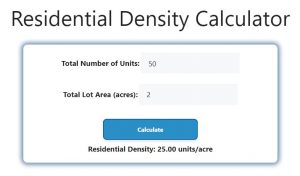About Residential Density Calculator (Formula)
Understanding residential density is crucial for urban planning, zoning, and development projects. The Residential Density Calculator allows planners, architects, and developers to assess how many housing units can be accommodated within a given area. This calculation helps ensure that developments meet regulatory requirements and serve the needs of the community effectively. In this article, we will explain the formula for calculating residential density, how to use the calculator, provide an example, and answer frequently asked questions.
Formula
The formula for calculating residential density is:
Residential Density = Total Number of Units / Total Lot Area.
How to Use
- Determine Total Number of Units: First, gather the total number of residential units that will be included in your calculation.
- Measure Total Lot Area: Next, measure the total lot area in square feet, acres, or another relevant unit of area.
- Input Values into the Formula: Substitute the total number of units and the total lot area into the formula to calculate the residential density.
- Calculate: Perform the division to find the residential density, which will be expressed in units per area (e.g., units per acre or units per square foot).
Example
Suppose a developer wants to calculate the residential density for a lot that has 50 housing units built on a total area of 2 acres.
- Total Number of Units = 50.
- Total Lot Area = 2 acres.
Using the formula:
Residential Density = 50 units / 2 acres = 25 units per acre.
In this example, the residential density is 25 units per acre, indicating that there are 25 housing units for every acre of land.

FAQs
- What is residential density?
Residential density refers to the number of housing units within a specific area, typically measured in units per acre or units per square foot. - Why is calculating residential density important?
It helps in urban planning, zoning regulations, and ensuring sustainable development practices. - What units can I use for total area?
You can use acres, square feet, or square meters, as long as you are consistent in your measurements. - How does residential density affect urban planning?
It influences infrastructure needs, public services, and community amenities based on the concentration of residents in an area. - Can residential density vary by zoning laws?
Yes, different zoning classifications may have specific density restrictions or allowances based on local regulations. - How do I determine the total number of units?
The total number of units can include single-family homes, multi-family units, or any residential structures planned for the site. - What is a typical residential density?
It varies widely based on location; urban areas may have higher densities (e.g., 50 units per acre), while rural areas typically have lower densities (e.g., 1-5 units per acre). - Can the residential density change over time?
Yes, changes in zoning laws, development patterns, or community needs can alter the acceptable residential density. - How does this calculator assist developers?
It helps developers determine how many units can be built on a lot, ensuring compliance with local regulations. - Are there limitations to using this formula?
Yes, the formula does not account for factors like infrastructure, environmental impact, or community needs, which should also be considered. - What is the difference between residential density and population density?
Residential density focuses on housing units, while population density measures the number of people living in a given area. - Can I use the calculator for mixed-use developments?
Yes, the calculator can also be applied to mixed-use developments, although the formula may need adjustment to reflect commercial and residential units. - What impact does high residential density have on a community?
Higher residential density can lead to increased demand for public services, traffic congestion, and pressure on infrastructure. - Is there a maximum residential density allowed?
Yes, maximum density limits are often defined by local zoning laws and regulations. - How can I find local zoning regulations?
Local government websites typically provide zoning maps and regulations for residents and developers. - What happens if I exceed the allowed residential density?
Exceeding density limits can result in penalties, fines, or the need to alter or reduce planned developments. - Can I convert commercial space to residential units?
Yes, but this may require zoning changes and adherence to local regulations. - Is residential density the same in all countries?
No, residential density standards can vary significantly based on local laws, culture, and urban planning practices. - How can I improve residential density without overcrowding?
Design strategies like vertical building and mixed-use developments can enhance density while maintaining livability. - Where can I find more information about residential density?
Urban planning textbooks, local government resources, and professional planning organizations provide comprehensive information on residential density.
Conclusion
The Residential Density Calculator is an essential tool for urban planners, developers, and architects. By understanding how to calculate residential density, stakeholders can make informed decisions about land use, zoning, and community planning. This calculation not only helps ensure compliance with regulations but also plays a vital role in promoting sustainable development practices that meet the needs of growing populations. Whether you’re planning a new project or assessing existing developments, using this calculator can streamline the process and enhance project outcomes.